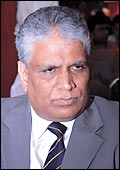|
A
year-and-a-half ago, at the 58th annual general meeting of the
Indian Banks Association (IBA) at Mumbai's NCPA centre, several
of the blue-chip public sector bank chairmen sat in the front
row, listening to Finance Minister P. Chidambaram. Nothing unusual,
except that there was an air of expectancy around the fm's speech.
Earlier in his opening remarks, IBA Chairman (and, then, State
Bank of India Chairman as well) A.K. Purwar had made a daring
suggestion to the fm to give banks greater autonomy in deciding
pay packets of senior management. Now, India's public sector banking
brass wanted to know how their political boss would react to the
suggestion.
Chidambaram, dressed in trademark veshti
and white shirt, addressed the issue in his inimitable style,
weighing each and every word that he uttered. "I am constrained
to point out," Chidambaram said, as the bank chairmen began
squirming in their seats, "that some of the banks have projected
a deposit growth in 2005-06, which is lower than that of 2004-05."
As the banking brass began wiping sweat off their faces, Chidambaram
continued, "If the rate of growth of the economy in 2005-06
is maintained at 7 per cent, then it is difficult to understand
how business projections by public sector banks, especially deposits
and advances, can evidence deceleration in growth. How can the
perceptions of the bankers be so different from that of the rest
of the economy?" he questioned. Predictably, there was pin-drop
silence in the hall as the fm wrapped up his speech.
If business performance has to be the measure
for determining remuneration of bank bosses, then the state-owned
banks have even less of a case today. As Chidambaram evidently
knew back then, the PSU banks have been facing a problem. Their
deposits haven't grown fast enough to keep pace with the surge
in credit that has happened due to economic expansion and boom
in consumption. For instance, for the third year in a row, bank
deposits have grown by just 15 per cent while credit has been
growing at twice the pace. A classic example: The Delhi-based
Oriental Bank of Commerce, whose credit disbursals have grown
at 33 per cent, but deposits at just 5 per cent.
 |
 |
"We are extremely careful in
doling out credit. We don't (lend) beyond a limit that we
can't manage"
V.P. Shetty
CMD/
IDBI Bank |
"These are issues that have
macro-economic implications, so one has to move carefully"
M.V. Nair
CMD/ Union Bank of India |
With the result, what the banks had been doing
was to dip into their own safe deposits, or statutory liquidity
ratio (SLR) that the Reserve Bank of India requires them to maintain
for safety. As a result, the SLR-held in the form of government
securities-at these banks has dropped from 41.50 per cent in March
2003 to 29.8 per cent in October 2006.
Should industry and other borrowers worry?
To some extent, yes. Slashing SLR further from the current mandatory
level of 25 per cent doesn't look like a real possibility, simply
because it will end up squeezing the credit to the government
of India. Says M.V. Nair, Chairman and Managing Director, Union
Bank of India: "These are issues that have macro-economic
implications, so one has to move very carefully." Adds V.P.
Shetty, CMD of the development-institution-turned-bank, IDBI Bank:
"We are extremely careful in doling out credit. We don't
(lend) beyond a limit that we cannot manage."
If the banks don't raise deposit in pace
with lending, they won't have any money (in a manner of speaking)
to lend to more profitable customers such as corporates and retail
consumers. On the other hand, if the banks do raise their deposit
rates to attract customers, they will have to necessarily hike
their lending rates as well, in order to protect their spreads.
And higher interest rates is the last thing the government or
the Reserve Bank of India (RBI) would like in an economy that's
clipping at 8 per cent a year. Reason: Inevitably, prices will
go up and consumers will cut back on their spending, putting the
brakes on an economy that's rolling. Admits Prakash Mallya, Chairman
and Managing Director of Bangalore-based Vijaya Bank: "It's
a Catch 22 situation for us."
The Way Out
Remember that earlier we had said that cutting
SLR further wasn't really an option. However, if it came to the
crunch, RBI Governor Y.V. Reddy may be forced to make a concession
and drop the limit to 20 per cent. Bankers point out that developed
countries such as the US only require 10 per cent of the deposits
to be kept in reserves. "There is definitely a case for SLR
reduction," says P.L. Gairola, CMD, Dena Bank. No one knows
for sure if Reddy will actually tinker with SLR, which has remained
untouched since 1997. It's more likely that he will want the PSU
banks to become more efficient and, hence, competitive.
 |
"It makes a lot of sense for PSU
banks to take the securitisation route to free up capital"
Rajesh Mokashi
Executive Director/ Care Ratings |
Currently, the cost of operations of PSU banks
is a little more than 1 per cent of the total working capital
funds. According to seasoned banker K. Cherian Varghese, former
chairman of Corporation Bank and Union Bank of India, a 0.75 per
cent savings in cost of operations would result in a 25 basis
points savings for the bank. This could act as a cushion if the
banks have to resort to other sources of capital such as bonds
(where the cost of funds is between 7 and 7.5 per cent), foreign
currency loans (7 per cent), and G-secs (7.5 per cent), as against
the prime lending rate (PLR) of 11-12 per cent. Yet, nothing beats
deposits in terms of costs, since they cost less than 5 per cent.
"We are focussing on a lot of cross-selling and a non-branch
model to acquire new customers," says B. Sambamurthy, CMD,
Corporation Bank.
Others such as the Union Bank of India are
coming up with more attractive deposit products-like the one that
doubles money in eight-and-a-half years. Often, the deposit schemes
are being launched in the face of competition from other aggressive
institutions. "We are pitted against postal deposits and
equity-oriented instruments," says Mallya. Worryingly for
the banks, there has been a shift in the nature of deposits to
short-term bulk deposits by corporates from retail deposits, which
have traditionally been the core of all deposits. That, in turn,
has resulted in shortening of deposit maturity. "Undoubtedly,
we need stable retail deposits to fund the higher credit growth,"
says Gairola. That the banks are scrambling for money is also
evident in the overnight call money market, where rates have shot
up to 20 per cent (week ended December 31, 2006)-the highest in
nine years.
Some Other Options
Given that a lot of PSU banks either already
have branches abroad or are opening them, raising deposits abroad
is an option too, but a limited one. Additionally, banks have
the option to borrow in foreign currency, but the "high forward
premia in the market has been discouraging bankers from utilising
this option," says Sambamurthy. The forward premia (over
libor, or London Interbank Offered Rate) are ruling at 3 per cent,
which leaves hardly any margin for the borrowing banks. (Banks
hedge their currency risks by fixing the exchange rate for repayment
by paying a premium.) That means, even if banks borrow from abroad,
they must find investment avenues that return higher than normal
lendings. As one can imagine, that's not the easiest of things
to do in a competitive market.
Yet another option for these banks could
be securitisation of their retail portfolios, which will allow
them to bundle all their retail loans (cars, home, credit card
etc.) and sell as a single marketable security. Private sector
banks such as ICICI Bank and HDFC Bank are already quite active
in the securitisation market. "It makes a lot of sense for
PSU banks to take the securitisation route to free up capital,"
says Rajesh Mokashi, Executive Director, Care Ratings. However,
a critical mass in terms of portfolio size will be needed for
securitisation.
 If
nothing works out, the banks may have to resort to raising capital
either via equity or debt, or a mix of both. But equity is expensive
and debt is usually costlier than deposits, besides which banks,
globally, never raise capital for the purpose of lending, which
is what the PSU banks in India will end up doing should they choose
this route. If
nothing works out, the banks may have to resort to raising capital
either via equity or debt, or a mix of both. But equity is expensive
and debt is usually costlier than deposits, besides which banks,
globally, never raise capital for the purpose of lending, which
is what the PSU banks in India will end up doing should they choose
this route.
There's good reason for the global practice.
Raising capital has a direct impact on the return on capital,
which is an indicator of efficient use of capital. Private sector
banks such as ICICI Bank, HDFC Bank and UTI Bank have an roc of
18-20 per cent, while PSU giants such as SBI and the Bank of Baroda
have an roc ranging between 13 and 19 per cent. Any reduction
in roc will further bring down the P-Es of public sector banks,
which anyway don't get the same multiples as private banks. And
as their owner, the government will be the biggest loser when
their market value drops. Says Mokashi. "Raising capital
is no solution."
There's hope yet. A recent study by rating
agency CRISIL reveals that the PSU banks' share in the country's
incremental savings has remained remarkably stable (and not declined)
over the past five years. With some smart marketing-and not to
mention better internal efficiencies-if the banks are able to
attract more depositors at no great additional cost, then their
woes may end. If not, they'll have to go knocking on the doors
of the central bank for relief.
|









 If
nothing works out, the banks may have to resort to raising capital
either via equity or debt, or a mix of both. But equity is expensive
and debt is usually costlier than deposits, besides which banks,
globally, never raise capital for the purpose of lending, which
is what the PSU banks in India will end up doing should they choose
this route.
If
nothing works out, the banks may have to resort to raising capital
either via equity or debt, or a mix of both. But equity is expensive
and debt is usually costlier than deposits, besides which banks,
globally, never raise capital for the purpose of lending, which
is what the PSU banks in India will end up doing should they choose
this route.